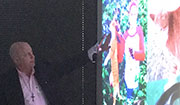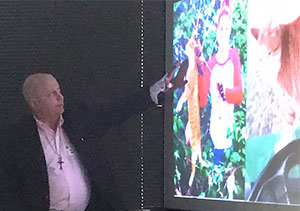

VIN News Service photo
Dr. Bill Folger was an expert witness for the state in its case against Dr. Kristen Lindsey. The feline specialist from Houston told administrative law judges during an April 26 hearing in Austin, Texas, that unique markings on the cat Lindsey killed identify the tabby as Tiger, owned by Lindsey's neighbors.
If Texas judges find Dr. Kristen Lindsey guilty of breaking administrative laws that warrant stripping the veterinarian of her license, Lindsey's attorney promises to appeal the case to District Court for Travis County.
Brian Bishop said he’s “disappointed” that administrative law judges Catherine Egan and Pratibha Shenoy denied his petition for a partial new trial. Their decision, filed Monday, also rejects Bishop’s plea to strike statements Dr. Bill Folger, a board-certified feline practitioner, made during a two-day hearing that ended April 26 in Austin, Texas.
“Dr. Folger’s testimony under cross examination showed that he was not objective and that he was willing to say anything it took to get to support the vet’s board’s narrative, even if the facts and the objective evidence didn’t support that narrative,” Bishop said by email. “There is no avenue to appeal the ruling at this point, but it will be raised in the District Court appeal …”
Folger, the state’s primary expert witness, presented evidence during the hearing that the cat Lindsey shot on April 15, 2015, with a bow and arrow was not an intact stray but a neighbor’s neutered tabby named Tiger. He testified that the arrow’s placement likely meant that the cat was still alive when Lindsey hoisted its body by the arrow and posed for a photo that she uploaded to Facebook with the caption, “My first bow kill... lol. The only good feral tomcat is one with an arrow through its head. Vet of the year award ... gladly accepted.”
That photo went viral and incited public outcry. Texas authorities got involved and convened a grand jury last summer that declined to indict Lindsey on criminal animal cruelty charges due to a lack of evidence. Texas law permits citizens to kill non-livestock animals on their property if the animals pose a threat or are being destructive. Lindsey stated that the cat she shot had been tearing into feed bags, repeatedly urinated on her porch and harassed her own cat.
Despite the grand jury's decision, state regulators determined that they didn't need a criminal conviction to find Lindsey guilty of animal cruelty, a violation of the Texas Veterinary Licensing Act that governs the profession.
The Texas Board of Veterinary Medical Examiners moved to revoke Lindsey's license, citing a "lack of empathy" that could pose a serious health hazard to patients. A complaint filed Oct. 2 with the State Board of Administrative Hearings asserted that Lindsey had breached the state licensing act by demonstrating unprofessional conduct and conducting dishonest or illegal practices.
"There is no sanction, short of revocation, that the board can impose that would sufficiently protect the public from respondent's poor professional character," the complaint said.
Lindsey countered that while her Facebook post was "flippant and facetious" and "terribly offensive to many people," it did not provide a legal basis for losing her license. Killing a feral cat on her property had nothing to do with her practice as a veterinarian, she said.
Folger, during the hearing in April, pointed out that the markings of the deceased cat in Lindsey's photo were strikingly similar to those of Tiger, the neighbors' neutered cat who had been missing since the shooting. A grainy image of the carcass Lindsey snapped more than 24 hours after she tossed the body into a ditch spurred contention. Lindsey asserted that the body showed a scrotum, proving the cat couldn’t have been Tiger. Folger asserted that a shiny mound of skin near the tail was not a scrotum but a prepuce with an atrophied scrotal sac next to it.
Six weeks after the hearing ended, Bishop filed a motion for a partial new trial. He said that Folger’s testimony was inconsistent with comments he made last year on his private Facebook page and in message-board discussions of the Veterinary Information Network, an online professional community that’s accessible only by members.
VIN is the parent of the VIN News Service.
In the VIN comments, Folger expressed disdain for Lindsey and made negative assertions about her character. The Facebook photo showed a “perfect kill shot thru the skull,” he wrote in July 2015 on VIN, speculating that Lindsey may have first immobilized the animal, possibly with a leg-hold trap, before taking aim and shooting.
The following April, however, Folger's perspective had changed. He testified during Lindsey's hearing that cat’s limbs appeared contracted in the Facebook photo. He deduced that the arrow pierced the lateral part of the eye, perhaps missing the brain. The cat's death likely wasn't instantaneous, he said.
“I don’t think the arrow went through the cat's skull. … That’s the only way to explain why the cat still has neuromuscular function,” Folger said during the hearing.
Folger has not commented since judges denied Lindsey's motion to have his testimony striken. During previous VIN News Service interviews, Folger explained that his opinions about the case changed after he was called to more carefully examine the evidence as the state’s primary expert witness.
Bishop said in court filings he was unaware of Folger’s negative opinions about Lindsey, having not been privy to the VIN discussions prior to the April hearing. Someone with access to VIN shared the message-board comments with Lindsey or her advocates in the weeks following.
Sharing material from VIN message boards violates VIN’s copyright and community rules. VIN officials have identified a member who admitted he played a role in sending Folger’s comments to Lindsey. He has been barred from the online community as VIN's investigation continues.
According to the ruling by the Texas administrative law judges, if Bishop was surprised about Folger’s online comments, it was a misstep on his part. During discovery phases, Bishop never petitioned for any statements Folger might have made about Lindsey, though state attorneys could have been provided them as a “professional courtesy,” the judges said. Additionally, Folger made similar comments on a publicly accessible blog that Bishop could have found in his research, the decision stated.
Moreover, Bishop’s petition is “premature,” the ruling stated, and cannot be considered until after the administrative law judges make a recommendation about the case that will go back to the TBVME, which has the final word on Lindsey’s professional fate.
The deadline for a recommendation from judges Egan and Shenoy is early October. TBVME could consider the case at its October meeting, but regulatory staff said it’s more likely to be presented to the full board on Jan. 24, 2017.